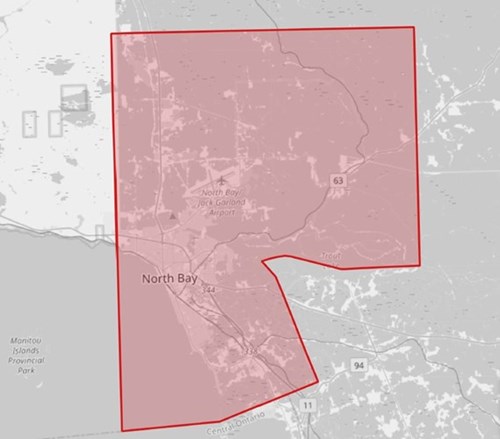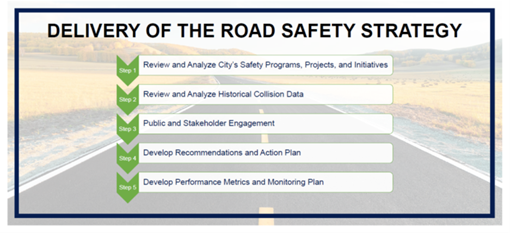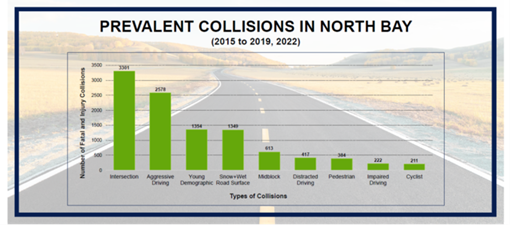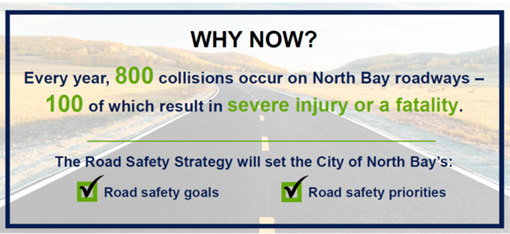North Bay Road Safety Strategy

Background
Road safety is not just a local concern but a critical issue for communities and individuals around the world. Vehicle collisions lead to deaths, injuries, economic costs, and life-altering consequences. Despite existing road safety initiatives, guidelines, and policies, approximately 800 collisions occur within our City each year, with over 100 causing injuries or deaths.
The City has recognized that a new and comprehensive road safety approach is required. This plan, inspired by "Vision Zero," will set out targets, policies, and action plans to guide the City and its road safety partners toward creating safer travel and reducing the number of fatal and serious injury collisions for everyone. As result of public and stakeholder consultation sessions the following Vision, Mission, and Goal statements, as well as Emphasis Areas have been identified.
Strategy Statements:
- Vision: Zero fatal and serious injury collisions on our roads.
- Mission: A data-driven and collaborative approach to prevent fatal and serious injury collisions and create a safe and efficient transportation system for all road users through community partnership, culture change, education, enforcement, and innovative design.
- Goal: Reduce fatal and serious injury collisions by a minimum of 15% within five years.
Emphasis Areas:
- Intersections: Countermeasures for this emphasis area may include signal phasing improvements (e.g., dedicated left turn phasing), a Red Light Camera (RLC) Program, protected intersection design, decreased curb radii, enhancement pavement markings, roundabouts, right-turn on red prohibitions, improvement sightlines, and more.
- Distracted Driving: Countermeasures for this emphasis area may include safety edges, educational campaigns, increased enforcement, and more.
- Aggressive Driving: Countermeasures for this emphasis area may include reduced lane widths, traffic calming, Automated Speed Enforcement (ASE), road diets, educational campaigns, reduced speed limits, school zones, and more.
- Pedestrians: Countermeasures for this emphasis area may include protected pedestrian crossings, Leading Pedestrian Intervals (LPIs), audible pedestrian signals, enhanced winter maintenance, improved street lighting, and more.
- Cyclists: Countermeasures for this emphasis area include dedicated and protected cycling infrastructure, crossrides, bicycle signals, coloured conflict pavement markings, educational campaigns, and more.
- School Zones: Countermeasures may include community safety zones, traffic calming (e.g., speed humps, narrowing lane width, curb extensions), school crossings, a crossing guard program, educational campaigns, enforcement, and more.
Key Components
- Evaluate existing safety programs;
- Form a Project Steering Committee with a clear mandate and procedures;
- Create a vision and goal with input from stakeholders;
- Identify focus areas using data and public input;
- Collaborate with stakeholders for efficiency and prioritize initiatives;
- Integrate safety assessment into existing plans and city design;
- Propose initiatives to address focus areas;
- Outline an action plan for study recommendations' implementation;
- Establish an evaluation and monitoring plan for strategy success;
- Develop a financial plan to identify resource needs and funding opportunities.
Public Engagement
Gathering feedback on potential safety issues is essential for this project. Public input will help define the project's mission, vision, goal statements, community concerns about road safety, and emphasis areas where allocating resources can enhance safety. The project team will meet with stakeholder groups and create a public opinion survey to engage residents and community members. Additionally, two Public Open Houses are scheduled to share initial project findings, gather public input, and address questions and comments.
Frequently Asked Questions
Road safety is a critical concern locally, nationally, and internationally.
The City of North Bay is developing a Road Safety Strategy (RSS) as a comprehensive plan to reduce traffic-related fatalities and injuries. The RSS, aligned with "Vision Zero" principles, outlines targets, policies, and action plans to enhance safety.
This strategy, serving as a roadmap, will guide short-term and long-term efforts over the next five years and beyond, ensuring coordinated and focused measures to prevent injuries and fatalities on city roads.
Vision Zero is a strategy supported by policies and data to eliminate traffic fatalities and serious injuries that have become popular with policymakers and the road safety community.
Vision Zero started in Sweden in 1997 with the premise that everyone has the right to move safely everywhere, and it can never be ethically acceptable that people are killed or seriously injured when moving within the transport system.
Therefore, system designers, operators, maintenance staff, and policymakers share the responsibility to provide a Safe System for all travellers irrespective of their chosen mode, income level, race, gender, or physical abilities.
However, we stress that Vision Zero is an aspirational long-term vision for road safety and can only be achieved by developing systematic road safety strategies with shorter-term (usually five years) realistic goals.
Moreover, the Vision Zero approach requires significant cultural and legislative changes regarding the approach taken toward traffic and road safety, road design, enforcement, and education of road users.
The City of North Bay has undertaken numerous initiatives in recent years to enhance road safety, including all-way stop controls, mid-block pedestrian crossings, and paved boulevards.
Despite these efforts, approximately 800 collisions, with over 100 resulting in serious injuries or fatalities, occur on City roads annually. Recognizing the need for a comprehensive approach, the City is proposing a five-year Road Safety Strategy.
This study aims to enhance safety for all road users across the entire City, irrespective of roadway classification or transportation mode. Refer to the diagram below for the City of North Bay boundaries.

The Road Safety Strategy will use various resources, including historical collision data and input from stakeholders and the public, to identify safety concerns.
The City is reaching out to residents and community members to engage them through the project website and online features, including a public opinion survey.
Share your thoughts on your experiences with current road safety using different modes of travel and your priorities, such as distracted driving, aggressive driving, speed, pedestrian collisions, and cyclist collisions.
Please Note:
New pedestrian crossovers are being installed throughout the reconstruction of Main Street through the 'Making Over Main Street' project. Pedestrian crossovers are new additions to the City. Please see the information below to make sure you are aware of the responsibilities of pedestrians, cyclists and drivers.


